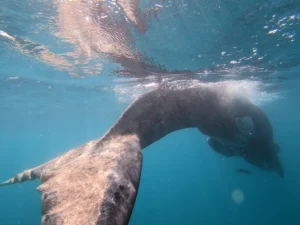Cape Town Freediving Clip of the Week 2:
Stephan spotted a large Red Roman hanging around while teaching an Adventure Freediver II freediving course in the Castle Rock area. We tend to see a lot of large Roman in the no-take areas of the MPA, but outside these areas they are quite scarce in the 0-15m zone, most likely due to overfishing. It’s always nice to get up close to these big red fish when the opportunity presents itself, so Stephan freedived down and got the clip of the week. As you can see in the video, these friendly fish are not skittish at all and will hang around divers for a while. Unfortunately this also makes them easy targets for spearos.
The Red Roman is a species of sea bream and its latin name Chrysoblephus laticeps describes it as a golden-eyed, broad headed fish. Adults are a red colour with white markings on the back and gill cover. It is a benthic predator which means that it hunts close to the sea floor. It likes eating crustaceans, echinoderms (particularly urchins), molluscs and worms. They can live up to 17 years. Females mature when they reach 17-20cm and can change sex to male at around 30cm. They then become very territorial. The Roman in this video has already transitioned to male and will have a home range of 1000 to 3000 square meters. These fish are found at depths of up to 100m. The adults tend to prefer deeper reef areas while the juveniles prefer shallow reef. When the water is warm they swim out in the open, but colder water pushes them into caves and crevices.
The name ‘Roman’ comes from the old Dutch name for the fish ‘Rooi man’ which means ‘Red Man’ in English. They have been found as high up as Namibia and on the east coast, but they are generally concentrated in the area between Cape Point and Port St Johns. They are a tasty fish and easy to hunt which has landed them on the SASSI Orange List so please think twice about eating them.



